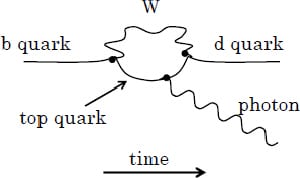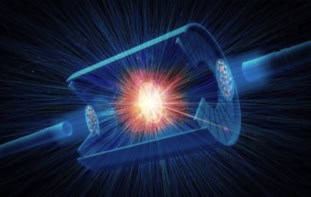The Belle collaboration at the KEK laboratory in Japan has observed a rare process whereby a bottom quark decays into a down quark, researchers announced at the Lepton-Photon symposium in Uppsala in Sweden this week. Although the decay is predicted by the Standard Model of particle physics, it could open a new window on the subatomic world because theories such as supersymmetry can also account for the process.

Quarks are the fundamental building blocks of protons, neutrons and other hadrons, and they come in six different “flavours”: up, down, charm, strange, top and bottom. Moreover, they are arranged in three generations: the first generation consists of the lightest (up and down) quarks, the second generation contains the charm and strange quarks, and the third generation contains the heaviest top and bottom quarks.
The KEK accelerator collides beams of electrons and positrons to produce pairs of B mesons, which contain bottom quarks and antiquarks. From a sample of about 390 million such events, the Belle detector registered 35 in which a B meson decayed into either a rho or an omega meson (which contain up and down quarks) plus a photon, and 30 events where a B meson disintegrated into two K mesons (one of which contained a down quark). These few events thus confirmed the first ever sighting of a bottom quark decaying into a down quark (figures 1 and 2).
The rarity of this decay is due to the generation structure of the Standard Model, which suppresses the decays of quarks from the third generation into those from the first — even though the latter are lighter than the third-generation quarks. In particular, the Standard Model predicts that a bottom quark transforms into a down quark via a two-step “penguin” process — so-called because its Feynman diagram is thought to look like a penguin (figure 3).
However, theories such as supersymmetry — an extension of the Standard Model in which every fundamental particle has a massive “super” partner — predict that this type of decay proceeds via a different process. The Belle observation therefore allows researchers to constrain physics beyond the Standard Model. Assuming that the standard theory does hold, however, the result provides a novel measurement of one of the parameters of the “CKM” matrix, which describes how quarks change flavour.
Also announced at the Sweden conference this week was the discovery of a massive new meson called the Y(4260) by physicists at the BaBar experiment at the Stanford Linear Accelerator Center. This particle, thought to consist of a charm-anticharm quark, does not decay as expected and adds to a growing number of “exotic” mesons recently discovered in particle physics labs, including KEK. These include the Y(3490), which may be related to the Y(4260), and the X(3872), which appears to be made of four quarks.





